The Contemporary Buttercream Bible (18 page)
Read The Contemporary Buttercream Bible Online
Authors: Christina Ong Valeri Valeriano

D
Tip
When piping petals, all you have to do is
position your nozzle at the right angle and
remember
these
three
words:
squeeze…stop…pull.
Hydrangea
1 Fill your piping bag with two colours of
buttercream (see the two-tone effect in Up and
201
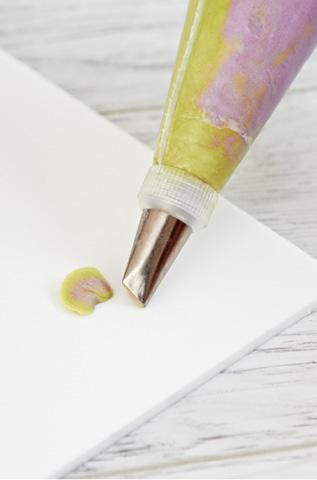
Down Two-tone Ruffles in Piping Textures and
Patterns). Using a small petal nozzle (Wilton 103),
hold the bag at a 20 to 30 degree angle with the
wide end of the nozzle touching the surface, then
give it a good squeeze until you create a fan shape.
Stop squeezing the bag and then gently pull it
towards you (A).
A
2 Repeat the same process and pipe three more
petals making sure that all petals will start at one
common point (B).
202
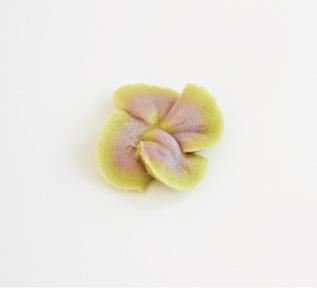
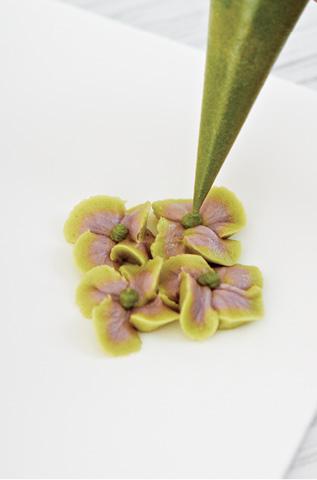
B
3 Pipe clusters of flowers to create the flowerhead of a hydrangea. Use green tinted buttercream to pipe
dots in the centre of each of the flowers (C).
203
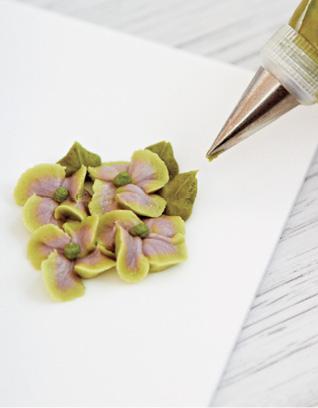
C
4 Pipe some leaves using a leaf nozzle (see
Sunflower and Leaves) (D).
D
Tip
Piping hydrangeas is easy, you just need to
connect all four petals at one central point. To
make them more realistic, use the two-tone
effect (see Up and Down Two-tone Ruffles in
Piping Textures and Patterns). And don’t
forget the magic words: squeeze... stop... pull!
204
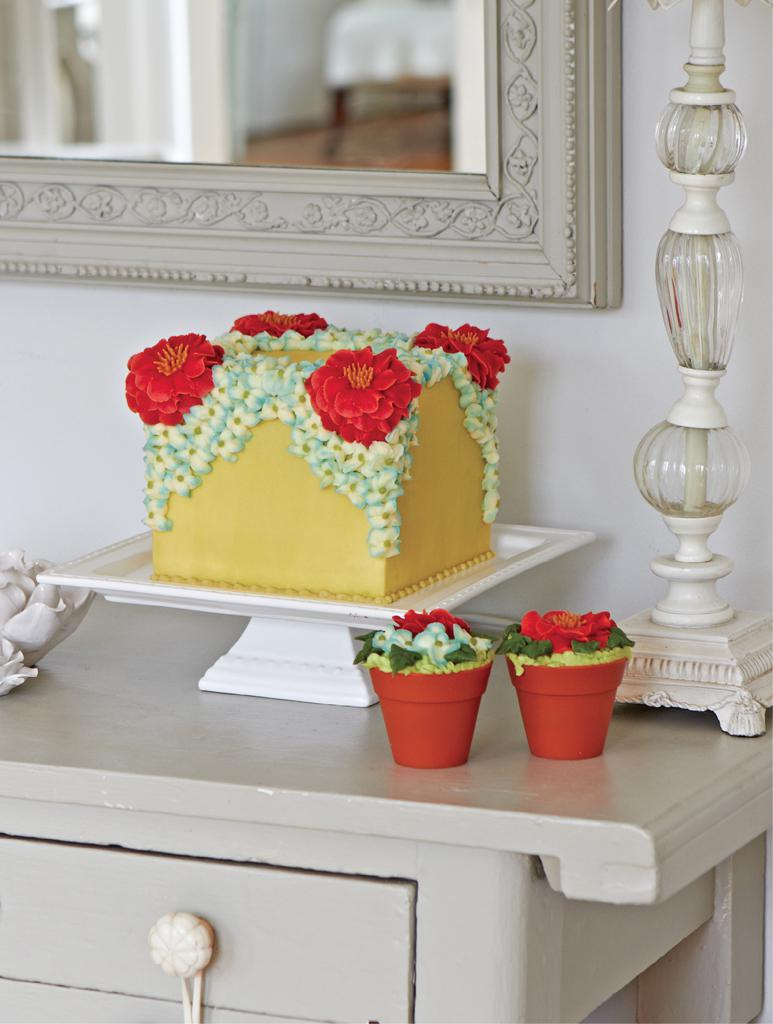
To create this cake…
• 15 × 13cm (6 × 5in) square cake
• 1.45–2.05kg (3lb 31⁄2oz–4lb 10oz) buttercream
205
• Paste colours: light yellow-green, (Sugarflair
Melon and Gooseberry), light blue (Sugarflair Baby
Blue), light green (Sugarflair Gooseberry), orange
(Sugarflair Egyptian Orange), yellow (Sugarflair
Autumn Leaf)
• Piping bags
• Petal nozzles (Wilton 103 and 104)
• Side scraper or ruler
• Scissors
• Cake stand or covered cake board
Crumb coat the cake (see Crumb Coating in
Buttercream Basics) and place on a stand or
covered cake board. Cover the cake with 500–600g
(1lb 2oz–1lb 5oz) of light yellow-green tinted
buttercream
and
smooth
the
surface
(see
Smoothing in Buttercream Basics). Colour the rest
of the buttercream in the following quantities:
150–250g (51⁄2–9oz) each of light blue, light green
and yellow, and 250–350g (9–12oz) orange. Leave
250–350g (9–12oz) of buttercream uncoloured.
Pipe the camellias on the corners in orange with
yellow centres, following the camellia tutorial. Pipe hydrangeas on the top edges and corners using light
206
blue and plain for the petals and green for the
flower centres, following the tutorial. Finish by
piping shells along the base of the cake in light
yellow-green (see Shells and Fleur-de-lis in Piping
Patterns and Textures).
207
Carnation and Sweet Pea
These two garden favourites are further examples of
easy-to-pipe flowers. Both are always in season
when it comes to cake decoration, and are the
perfect choice for both full-size cakes and cupcakes.
Sweet peas make a good alternative if you want
something different from swirls, and they are also
good ‘filler flowers’ for a more elaborate floral
arrangement.
208
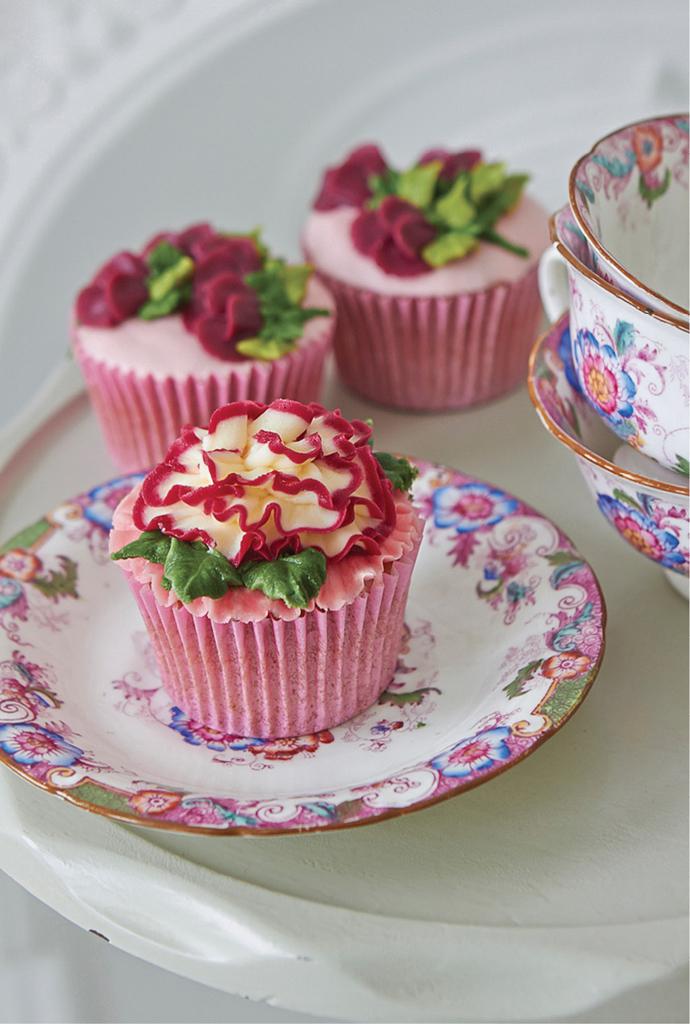
The frilly two-tone petals of a carnation make the
perfect decoration for a cupcake and are much more
exciting and original than your average swirl. When
209
paired with cupcakes in pink paper cases and pretty
vintage china they make a real statement –
experiment with colours that go well with your own
vintage crockery. A simple ruffle effect was piped
round the edge of this cupcake in pink buttercream
first (see Piping Textures and Patterns) before
piping the carnation in the centre and then the
leaves (see Sunflower and Leaves earlier in this
chapter).
Carnation
1 Create a two-tone effect by filling a piping bag
(with attached small petal nozzle, Wilton 104) with
two desired colours of buttercream in separate bags
(see Up and Down Two-tone Ruffles in Piping
Textures and Patterns). The ‘stripe’ colour will be
the one in the narrow end of the nozzle.
2 Using a piping bag with a writing nozzle, pipe a
circle as a guide to the size of your flower. With the nozzle at a 20 to 30 degree angle and the wider end
touching the surface (A), continuously squeeze the
piping bag as you move it slightly up and down to
create wavy petals. Pipe a circular row of petals
following the guide circle (B).
210
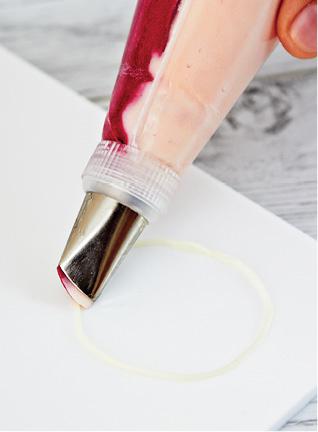
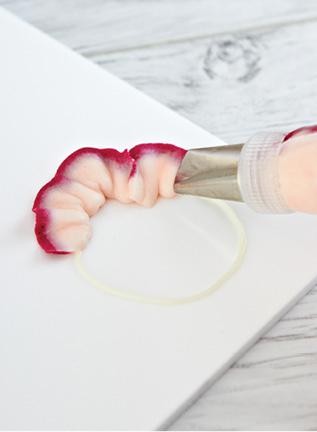
A
211
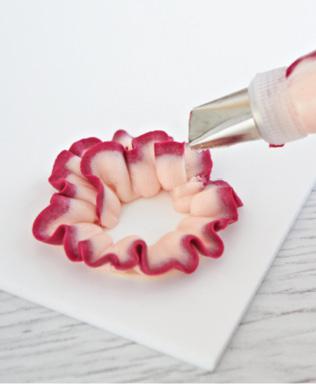
B
3 Pipe another row of petals, starting slightly inside the first circle, with the wide end of the nozzle held at a 30 to 40 degree angle and touching the first
row of petals (C).
